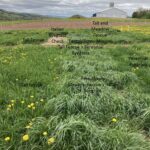Festulolium (Perennial X Meadow)
Festulolium loliaceum
General Description
Festulolium is the name for a hybrid forage grass developed by crossing certain fescues and ryegrass. This enables combining the best properties of the two types of grass. The resulting hybrids have been classified as:
Maternal parent
Festuca pratensis (Meadow Fescue)
Paternal parent
Lolium perenne (Perennial Ryegrass)
Hybrid progeny
Festulolium lollaceum
As with most hybrids, the plant breeders attempt to breed the best parts of both parent varieties into the hybrid to create something that improves on the parents’ traits with hybrid vigour. The fescues generally are high yielding and winter hardy, while the ryegrass varieties are very palatable with high sugar and protein content. Particular attention should be given to hybrid selection to ensure that your desired outcomes are met. There are a wide range of hybrids even within each hybrid segment depending on the characteristics and phenotypes which have been created.
From F. pratensis: improved root structure, improved animal palatability to late seed head formation ryegrass, persistent green gene effect, perenniality, extreme cold tolerance.
From L. perenne: higher degree of persistence, rapid seedling establishment, strong winter activity and early spring growth and overall seasonal yield to meet livestock needs, high seed production potential, good resistance to crown and stem rust and net blotch and fusarium.
Type
Tame grass.
Origin
The first Festulolium hybrids were listed in the USA and the UK already in the 1960s. The first hybrids used in agriculture were listed in the end of 1980’s and beginning of 1990’s in Germany, former Czechoslovakia and Poland.
Longevity
Persistence is dependent on variety. A Perennial Ryegrass x Meadow Fescue hybrid has potential to persist with proper hybrid selection. Most festuloliums are not to be considered a “permanent” forage grass species in Eastern Canada.
Use
Pasture, hay, silage or stockpiled.
Optimal Time of Use
Spring, summer, fall, winter. Hay festulolium by early heading. Regrowth may be grazed or stockpiled. Festulolium can be continually or rotationally grazed. Enter at 25-30 cm (10-12 in) and Leave at least 7.5 -10 cm (3-4 in) for substantial regrowth to occur. Basal leaf growth develops from new tillers throughout the season. Begins growing a little later than other grass- manage accordingly. Good for summer grazing or stockpiling for fall and early winter grazing as it maintains quality well after fall frosts and stands erect through light snowfall. Ideal haylage and silage stage is early boot stage.
Recovery After Use
Festulolium performs best under a rotational grazing system and should be grazed down to 7.5-10 cm (3 to 4 inches) when plants reach a height of 25-30 cm (10 to 12 in).
Palatability/Nutritional Value
Excellent palatability in vegetative stages.
Drought Tolerance
Moderate tolerance.
Flooding Tolerance
Withstands 2-5 weeks of spring flooding. It withstands wet soils season long.
Winter Hardiness
Fair to good tolerance depending on the hybrid. Winter is highly dependent on variety, snow cover conditions, drought, and breaks in dormancy.
Soil Texture Preference
Prefers deep, moist, silty to clayey soils.
Erosion Control
Moderate erosion control.
Salinity Tolerance
Moderate tolerance.
Acidity Tolerance
Moderate tolerance.
Alkalinity Tolerance
High tolerance.
Seeds per kg
499,400 seeds/kg (227,000 seeds/lb)
Suggested Mixtures
Festulolium is compatible in mixes. Species include alfalfa, clovers, birdsfoot trefoil, meadow fescue, orchardgrass.
Ease of Establishment
Festulolium is easy to establish due to its rapid germination and seedling vigor.
Competitiveness
Once established, meadow fescue hybrid festuloliums can be competitive.
Management Considerations
Festulolium seeds should be planted at 25 to 35 lbs. per acre alone, or at 5 to 20 lbs. per acre if included in a combination with other species. Seeding depth is 1/4 inch. In general, 150 pounds of nitrogen per acre per year will be adequate to maintain a good stand of festulolium. The guideline is to apply 1/3 of the nitrogen in the spring with the balance evenly applied after each harvest or grazing period.
OMAFRA Publication 30: https://www.ontario.ca/files/2022-10/omafra-guide-to-forage-production-en-2022-10-19.pdf
NA
